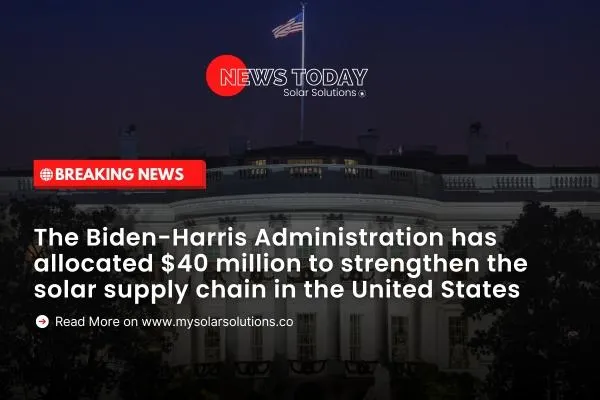NEWS
BREAKING NEWS

The Biden-Harris Administration has allocated $40 million to strengthen the solar supply chain in the United States
The Biden-Harris Administration is taking significant steps to bolster the domestic solar supply chain with a recent announcement of $40 million in funding aimed at enhancing solar manufacturing capabilities. This initiative is a game-changer for the renewable energy sector and comes as a much-needed support for domestic solar energy production. Let's dive into the details and explore the implications of this investment.
Understanding the Solar Supply Chain
Before we delve deeper, it's essential to grasp what the solar supply chain encompasses. In simple terms, the supply chain for solar energy involves everything from the production of raw materials to the manufacturing of solar panels and their eventual installation.
Key Components of the Solar Supply Chain
Raw Materials: This includes silicon, glass, and metals that serve as the foundation for solar panels.
Manufacturing: The transformation of raw materials into solar cells and panels.
Distribution: The logistics involved in transporting solar products to various locations.
Installation: The final step where solar panels are fitted onto homes or businesses.
End-User: Homeowners or enterprises that utilize solar energy.
See If your Home Qualifies For Government Grants and Solar Tax Credits
Why Is This Investment Important?
The recent announcement isn't just a casual drop in the bucket; it's a pivotal point in the evolution of solar energy in the U.S. Here's why this investment matters:
1. Strengthening Domestic Manufacturing
For years, the U.S. has relied on imported solar components, which has made us vulnerable to global supply chain disruptions. With this $40 million push, we are looking to:
Increase the production of solar components domestically.
Create jobs within the solar manufacturing sector.
Reduce dependency on foreign suppliers.
2. Enhancing Energy Security
Imagine being able to rely on local resources; it sounds comforting, right? By enabling a robust domestic supply chain, we can enhance our energy security. Here's what that means:
Less Vulnerability: We won't be as affected by international conflicts or trade disputes.
Sustainable Practices: Local manufacturing can be aligned with sustainable practices, ensuring lower carbon emissions.
3. Supporting Innovation and Technology
The future of solar energy is bright, and a major part of that vision is driven by innovation. This funding will support:
Research and Development: New technologies can emerge from innovative manufacturing processes.
Job Creation: More research means more jobs for scientists, engineers, and technicians.
How Will the Funding Be Allocated?
The Biden-Harris Administration has laid out a clear strategy for how the $40 million will be deployed to maximize its impact.
Funding Levels
Research Grants: A significant portion will go toward securing grants for groundbreaking solar technology.
Manufacturing Incentives: Funds will be available for companies that commit to expanding their production capabilities stateside.
Infrastructure Development: Investing in manufacturing facilities that can produce solar components at scale.
The Impact on the Job Market
Let’s face it: job creation is a hot topic. The solar industry has proven to be a driving force for employment. With these new funding opportunities, we expect to see:
New Positions Created: From manufacturing to installation, new roles will emerge.
Training Programs: More jobs mean a need for training programs to prepare the workforce.
Specific Job Opportunities Expected
Manufacturing Roles: Workers needed in factories.
Technical Experts: Engineers specializing in solar technology.
Installation Technicians: Skilled labor to install solar energy systems.
See If your Home Qualifies For Government Grants and Solar Tax Credits
Anticipated Benefits to Communities
Local communities are bound to feel the ripple effects of this investment. Here are some potential benefits:
Economic Growth: More jobs often lead to increased spending in local businesses.
Reduced Energy Bills: With more solar energy production, we can expect lower energy costs for residents.
Environmental Benefits: A shift towards solar energy contributes to greener communities.
Solar Energy: A Path to Sustainability
It’s no secret that solar energy is a cornerstone of sustainability efforts across the globe. By strengthening the domestic solar supply chain, we pave the way for:
Transitioning to Renewable Energy: Reducing our carbon footprint is essential in the fight against climate change.
Public Health Improvements: Cleaner energy sources result in better air quality.
Exploring the Future of Solar Energy
What does the future hold for solar energy? With continuous investments, we can expect:
Increased Adoption: More homeowners will opt for solar systems.
Technological Advancements: From more efficient panels to energy storage solutions.
Global Leadership: The U.S. can lead the way in solar energy innovation and production.
Challenges Ahead
While the future looks bright, we must address the challenges that come with it:
Competition: We are competing with countries that have established solar industries.
Infrastructure Costs: Upgrading facilities requires upfront investments.
Policy Regulations: Navigating the ever-changing policy landscape can be complicated.
The Biden-Harris Administration's $40 million investment in the domestic solar supply chain is a crucial move towards building a sustainable energy future in the United States. This funding will not only support the growth of manufacturing but also create jobs and enhance our energy security. As we continue to navigate the complexities of the energy landscape, we must rally around this initiative, recognizing that solar energy is not just an alternative; it's our pathway to a sustainable future.
See If your Home Qualifies For Government Grants and Solar Tax Credits
FAQs
1. How will the $40 million funding be used?
The funding will be allocated to enhance manufacturing capabilities, support research and development, and develop infrastructure for solar energy production.
2. What are the expected job opportunities from this investment?
Job opportunities will include manufacturing roles, technical experts, and installation technicians in the solar sector.
3. How does strengthening the solar supply chain enhance energy security?
A robust domestic supply chain reduces reliance on foreign imports, minimizing vulnerability to global disruptions.
4. What are the environmental benefits of investing in solar energy?
Investing in solar energy leads to reduced reliance on fossil fuels, lower carbon emissions, and improved public health through better air quality.
5. What challenges does the U.S. face in the solar industry?
Challenges include competition from established solar industries in other countries, infrastructure costs, and navigating complex policy regulations.

